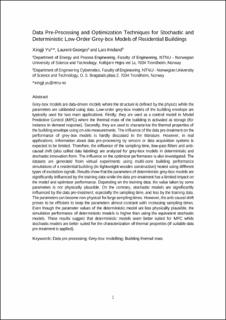| dc.contributor.author | Yu, Xingji | |
| dc.contributor.author | Georges, Laurent | |
| dc.contributor.author | Imsland, Lars Struen | |
| dc.date.accessioned | 2022-08-08T07:44:16Z | |
| dc.date.available | 2022-08-08T07:44:16Z | |
| dc.date.created | 2021-04-14T14:51:47Z | |
| dc.date.issued | 2021 | |
| dc.identifier.citation | Energy and Buildings. 2021, 236 1-17. | en_US |
| dc.identifier.issn | 0378-7788 | |
| dc.identifier.uri | https://hdl.handle.net/11250/3010517 | |
| dc.description.abstract | Grey-box models are data-driven models where the structure is defined by the physics while the parameters are calibrated using data. Low-order grey-box models of the building envelope are typically used for two main applications. Firstly, they are used as a control model in Model Predictive Control (MPC) where the thermal mass of the building is activated as storage (for instance in demand response). Secondly, they are used to characterize the thermal properties of the building envelope using on-site measurements. The influence of the data pre-treatment on the performance of grey-box models is hardly discussed in the literature. However, in real applications, information about data pre-processing by sensors or data acquisition systems is expected to be limited. Therefore, the influence of the sampling time, low-pass filters and anti-causal shift (also called data labeling) are analyzed for grey-box models in deterministic and stochastic innovation form. The influence on the optimizer performance is also investigated. The datasets are generated from virtual experiments using multi-zone building performance simulations of a residential building (in lightweight wooden construction) heated using different types of excitation signals. Results show that the parameters of deterministic grey-box models are significantly influenced by the training data while the data pre-treatment has a limited impact on the model and optimizer performance. Depending on the training data, the value taken by some parameters is not physically plausible. On the contrary, stochastic models are significantly influenced by the data pre-treatment, especially the sampling time, and less by the training data. The parameters can become non-physical for large sampling times. However, the anti-causal shift proves to be efficient to keep the parameters almost constant with increasing sampling times. Even though the parameter values of the deterministic model are less physically plausible, the simulation performance of deterministic models is higher than using the equivalent stochastic models. These results suggest that deterministic models seem better suited for MPC while stochastic models are better suited for the characterization of thermal properties (if suitable data pre-treatment is applied). | en_US |
| dc.language.iso | eng | en_US |
| dc.publisher | Elsevier | en_US |
| dc.rights | Attribution-NonCommercial-NoDerivatives 4.0 Internasjonal | * |
| dc.rights.uri | http://creativecommons.org/licenses/by-nc-nd/4.0/deed.no | * |
| dc.title | Data pre-processing and optimization techniques for stochastic and deterministic low-order grey-box models of residential buildings | en_US |
| dc.type | Journal article | en_US |
| dc.type | Peer reviewed | en_US |
| dc.description.version | acceptedVersion | en_US |
| dc.rights.holder | This article will not be available until April 1, 2023 due to publisher embargo - This manuscript version is made available under the CC-BY-NC-ND 4.0 license | en_US |
| dc.source.pagenumber | 1-17 | en_US |
| dc.source.volume | 236 | en_US |
| dc.source.journal | Energy and Buildings | en_US |
| dc.identifier.doi | 10.1016/j.enbuild.2021.110775 | |
| dc.identifier.cristin | 1904055 | |
| dc.relation.project | Norges forskningsråd: 257660 | en_US |
| cristin.ispublished | true | |
| cristin.fulltext | postprint | |
| cristin.qualitycode | 2 | |

